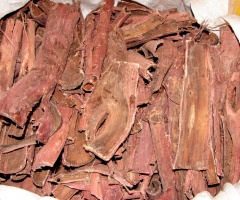Mimosa Extract
| Infobox on Mimosa Extract | |
|---|---|
| Example of Mimosa Extract |  |
| Facts | |
| Origin | See text |
| Stowage factor (in m3/t) | 2,65 m3/t (mimosa bark unpressed bales) |
| Humidity / moisture | - |
| Oil content | - |
| Ventilation | - |
| Risk factors | See text |
Mimosa Extract
Description / Application
Mimosa tenuiflora is a perennial tree or shrub native to the northeastern region of Brazil (Paraíba, Rio Grande do Norte, Ceará, Pernambuco, Bahia) and found as far north as southern Mexico (Oaxaca and coast of Chiapas). It is most often found in lower altitudes, but it can be found as high as 1.000 m.
The fern-like branches have leaves that are Mimosa like, finely pinnate, growing to 5 cm long. Each compound leaf contains 15-33 pairs of bright green leaflets 5-6 mm long. The tree itself grows up to 8 m tall and it can reach 4–5 m tall in less than 5 years. The white, fragrant flowers occur in loosely cylindrical spikes 4–8 cm long. In the Northern Hemisphere it blossoms and produces fruit from November to June or July. In the Southern Hemisphere it blooms primarily from September to January.
The tree's bark is dark brown to gray. It splits lengthwise and the inside is reddish brown.
The tree's wood is dark reddish brown with a yellow center. It is very dense, durable and strong, having a density of about 1.11 g/cm3.
Mimosa tenuiflora does very well after a forest fire, or other major ecological disturbance. It is a prolific pioneer plant. It drops its leaves on the ground, continuously forming a thin layer of mulch and eventually humus. Along with its ability to fix nitrogen, the tree conditions the soil, making it ready for other plant species to come along.
Mimosa tenuiflora is a very good source of fuel wood and works very well for making posts, most likely because of its high tannin content (16%), which protects it from rot. Due to its high tannin content, the bark of the tree is widely used as a natural dye and in leather production. It is used to make bridges, buildings, fences, furniture and wheels. It is an excellent source of charcoal and at least one study has been done to see why this is the case.
Shipment / Storage / Risk factors
An extract of mimosa or wattle bark, usually shipped in bags and used in the tanning industry. It absorbs moisture when the air is humid. Absorption of moisture does not in itself cause damage, but as the extract is soluble in water, excessive wetting may affect the colour and possibly the quality of leather produced. Excessive moisture, excessive heat, lack of suitable ventilation, or excessive superincumbent weight may cause the extract to become soft and exude from the bags and stick to other bags, adjacent cargo or ship’s structure. Faults in manufacture could be responsible for softening. May be subject to loss in weight due to drying out.











